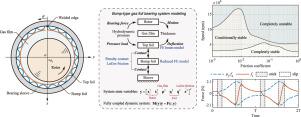Modeling and stability characteristics of bump-type gas foil bearing rotor systems considering stick–slip friction
Abstract
Frictional energy dissipation inside the foil structure is considered as a key factor in improving the stability of the gas foil bearing (GFB) rotor system. However, the effect and mechanism of friction on the stability of bump-type GFB rotor systems have remained partially addressed. This study aims to develop a novel comprehensive model to investigate the stability and frictional dissipation mechanism of the GFB rotor system. The LuGre dynamic friction model is adopted to capture accurate stick–slip states. The model order reduction technique and simultaneous solution framework are applied to improve the computational efficiency. The effect of friction on linear and nonlinear stability is investigated based on the proposed model, and an analysis of frictional dissipation is performed to explain the mechanism. The results reveal that the dissipation capacity of the foil structure is directly governed by the stick–slip states that are affected by the friction coefficient and disturbance magnitude, so the optimal friction coefficient for nonlinear stability is higher than the one for linear stability of the GFB rotor system. A further comparison between different friction models greatly highlights the necessity of the ability of the friction model to capture accurate stick–slip states.


 求助内容:
求助内容: 应助结果提醒方式:
应助结果提醒方式:


